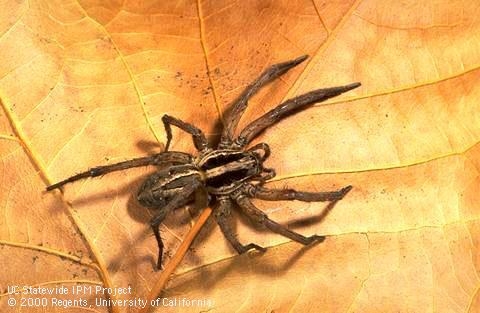By Michelle Ramsey, Butte County Master Gardener, August 23, 2013

Wolf spiders provide natural control of harmful insects. The Carolina Wolf Spider (Hogna carolinensis) is the largest of the wolf spiders. It is brown with black markings. Its body can measure more than one-inch long (and the whole spider can measure 4 inches across, from legs to legs). Female wolf spiders are larger than males; their undersides are solid black. Because some wolf spiders are large and hairy, they are sometimes mistaken for tarantulas.
Wolf spiders are not known to be aggressive but will bite if provoked or threatened. Their bite is not considered dangerous to people but it can be painful (like a bee sting). When disturbed, they will retreat very quickly.
Young wolf spiders hatch from eggs and look like tiny adults. They shed their skin as they grow. Males reach maturity from spring to summer. Mating occurs in autumn and the males die before the winter begins. Females lay eggs soon after mating. They carry their egg sacs in a silk cocoon attached to their abdomen by spinnerets. The spiderlings hatch in June and July and attain only half of their full size by the following winter. After hatching, the spiderlings cling to the mother’s body for about a week before detaching. They too will overwinter and complete their growth the following spring and summer. Female wolf spiders may live for several years. It is common to find females carrying their young spiderlings on their backs during the summer months. They can be a common pest in the fall when they begin to seek shelter from cooling temperatures.
The wolf spider is a solitary creature, preferring to live and hunt alone. Most are wanderers without a permanent home; however some Carolina wolf spiders create deep tubular burrows to live in. While wolf spiders prefer to live outdoors on the ground, they may occasionally wander indoors, where they might be found around doors and windows, and in garages. They may be seen running across the floor when disturbed. To keep spiders out of your home, seal cracks, gaps and other openings. For immediate and long-term control of wolf spiders, physical removal and/or destruction of the individual spider may be the best control.
For further information visit: http://www.ipm.ucdavis.edu/QT/commongardenspiderscard.html